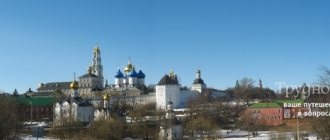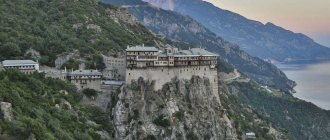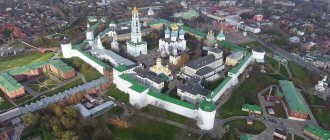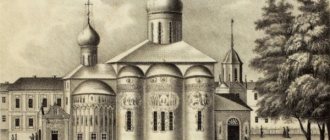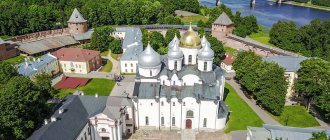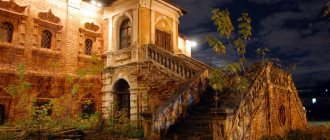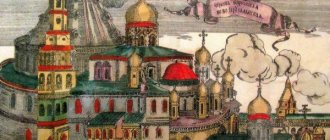The Trinity Lavra of Sergius is a visiting card, the main significant place of Sergiev Posad. It was she who gave rise to the formation of the city and became the pride of Russian Orthodoxy. From the moment of its foundation and in all subsequent times, this monastery has been and remains one of the main attractive spiritual and cultural centers. It is impossible to walk around, comprehend and evaluate all the buildings of the Lavra, and there are more than 50 of them, in one or two visits.
The monastery was always reconstructed, remodeled and updated. Life activity in it did not stop or freeze for a minute, and, probably, not a single building retained its original image. Several roads lead to the Lavra; the main gate is the Holy Gate with the Church of the Nativity of John the Baptist, built in the 17th century.
Every year, thousands of believers make a pilgrimage to the Trinity-Sergius Lavra to see the shrines of the monastery, get acquainted with its history and architecture, and take part in divine services.
Hotels near the Trinity-Sergius Lavra
Holy Trinity Sergius Lavra. History, description
Origin of the name and its meaning
The birth of the monastery dates back to 1337. It was founded by the monk Stefan and his younger brother Bartholomew, 70 km from Moscow. The brothers led a hermit life. Before 1340, they built the first church and a few cells.
Soon Stefan moves to the Moscow Epiphany Monastery. The future Saint Sergius was left alone, but soon ascetics settled near him. A monastery arose, first a special monastery, and then a cenobitic one. The first abbot was Mitrofan, who tonsured Bartholomew into monasticism with the name Sergius.
After the death of Mitrofan, Sergius becomes the permanent abbot of the monastery. The main church of the monastery remained the wooden Church of the Holy Trinity. The monastery also received the name Trinity.
In conditions of fragmentation and disasters caused by the Tatar-Mongol yoke, the monastery led by St. Sergius became the support and spiritual guide of the Moscow princes.
Saint Sergius of Radonezh blessed Prince Dmitry Donskoy for the decisive battle with the Horde in 1380 and predicted victory for the Russian army. The battle, which went down in history as Kulikov, predetermined the overthrow of the yoke. Saint Sergius of Radonezh reposed in 1392. His holy relics are located in the Church of the Holy Trinity on the territory of the monastery.
History of the Holy Trinity Sergius Lavra
The work and prayer of monks in the wilderness became a feat.
Hegumen Sergius forbade the brethren to beg for alms, earning food with their own labor.
The spiritual success of Sergius of Radonezh was obvious. His holiness, combined with simplicity and wisdom, attracted people from all over the country to the monastery.
He worked hard to unify Rus'. To reconcile the warring princes, he visited Nizhny Novgorod in 1365, Ryazan in 1385, and Pereslavl-Zalessky in 1374. Under the leadership of Saint Sergius of Radonezh, numerous monks grew spiritually. The saint's disciples became bearers of a genuine monastic tradition.
Having penetrated into the most remote corners of the country, they had a huge impact on society, showing people examples of personal holiness. 70 of them were canonized by the Church. In the northern lands, previously sparsely populated by people, this influence was especially strong and beneficial. Settlements arose around the new monasteries, and empty lands were reclaimed.
The monastery was besieged by the troops of False Dmitry II in 1608-1610. Moscow was ruled by Tsar Vasily IV. The impostor False Dmitry II settled in Tushino near Moscow with a large army of foreigners, defectors and adventurers.
The Holy Trinity Lavra of Sergius is located on the outskirts of Moscow. They attached great strategic and political importance to the seizure of the monastery. The army of interventionists and other supporters of the “Tushino thief” many times exceeded the forces of the defenders.
The main motives were the recognition of False Dmitry as king and the plunder of the Lavra. For the defenders, defending the monastery was a matter of spiritual achievement. People died every day from hunger and shells, but they struck back with artillery, made forays into the enemy’s camp, prayed and performed divine services.
The general assault on the Lavra took place on August 7, 1609. The garrison of the monastery numbered about 200 people and was doomed, but the besieging invaders got confused in the signal system, mistaking friendly Russian troops for the enemy in the darkness of the night. In the ensuing massacre, the Tushin units destroyed each other. The Lavra artillery fired continuously.
A large army of Prince Skopin-Shuisky advanced to help the besieged. On January 12, 1610, the exhausted and thinned troops of False Dmitry began to retreat randomly to Dmitrov.
The example of the Lavra raised the morale of the Russian people. Two years later, the monastery became one of the centers of unity, ensuring the success of the militia of Minin and Pozharsky. Moscow was liberated, the era of the Time of Troubles ended.
During the Streltsy riot of 1682, the future Emperor Peter I with his brother and mother found protection behind the monastery fortifications. 7 years later, the monastery again saved Peter I, who fled from the capital. In 1700 the Northern War broke out. Peter I took large financial resources from the monastery funds for the needs of the army.
The reign of Elizabeth Petrovna (1741-1761) is considered the heyday of the monastery. The opening of a theological seminary in 1742 and the assignment of the status of Lavra in 1742, under the control of the Moscow Metropolitan, are associated with it.
Large-scale stone construction is underway. Old buildings were redesigned and numerous new ones were erected. The magnificent decoration of the erected buildings met the requirements of architecture and modern reconstruction of the monastery.
The Holy Trinity Lavra of Sergius now has the status of the largest landowner, a religious center with a powerful infrastructure. There was active trade, the monastery donated huge funds to the needs of the army. In 1905, the monastery opened its own printing house. The authority of the monastery is illustrated by the transfer, in 1814, of the Moscow Theological Academy to its territory.
By the time of the October Revolution, a large city had grown up around the monastery, the infrastructure of which depended on the economic activities of the monastery. The number of inhabitants was about 400 people.
After the revolution of 1918, the Lavra was closed and the theological academy was dissolved. In 1920, the monastery complex was declared a museum. Divine services ceased by 1929, with the closure of the last monasteries. Most of the oldest bells were confiscated for melting down (two bells, from the 15th and 16th centuries, survived)
During the Stalin era, some of the monastery buildings were rebuilt, adapting them for educational institutions, residential and utility premises.
In 1940, the Lavra was declared a state museum-reserve. Funds are allocated and the largest restoration in the country is carried out. In 1945, an entire school was opened to train restoration specialists.
After the Great Patriotic War, the laurels were returned to the Church. In the winter of 1946, services resumed in several churches of the monastery. The Patriarch becomes the abbot of the monastery. Until 1983, the Lavra was the residence of Russian patriarchs.
On Holy Saturday 1946 the relics of St. Sergius were returned to the Church. The Theological Academy has again begun training pastors. The monastery was shown to foreign delegations, illustrating the “freedom of religion” in the Soviet state, which did not mean an end to the facts of arrests, exiles and other persecutions of believers.
Requests to the country's leadership for the return of the monastery's churches were granted. In 1956-1958 the entire monastery complex was returned to the Church.
Current status of the Holy Trinity Sergius Lavra
The Holy Trinity Lavra of Sergius has the status of a monastic town, with infrastructure focused primarily on the needs of the Church. A publishing house of Orthodox literature and a pilgrimage center operate successfully. There is the largest center of spiritual education - MDA.
Many ancient books in the monastery library have been scanned and presented online. About 15,000 manuscripts are freely available. The Lavra houses an Architectural Center and an icon-painting workshop that is continuously engaged in the restoration of the cultural and spiritual heritage of the monastery.
Currently, the number of inhabitants of the monastery is about 200 monks. Since 1988, the vicar has been the suffragan Archbishop Theognostus. The most important decisions are made collegially by the Spiritual Council. The Lavra traditionally attracts numerous Orthodox pilgrims. The flow of foreign tourists, especially from China, is growing.
Founder - St. Sergius of Radonezh
Bartholomew - this is the worldly name of the “abbot of all Rus'” - comes from a pious, apparently impoverished boyar family. At least the “Life” of the monk describes that his parents lived simply, and Bartholomew himself constantly helped them in the household.
St. Sergius of Radonezh. The earliest depiction of the venerable.
The compilers of the “Lives” of the saint especially pay attention to the seal of God’s chosenness that lay on the boy even before his birth:
- according to legend, when the boy’s mother, Maria, being pregnant, was at a church service, the son cried out three times in her womb;
- Having been born, Bartholomew refused mother’s milk on fasting days, and if Mary happened to eat meat, on others as well; so the mother had to fast in order to feed the baby.
Seeing all this, the parents understood: Bartholomew was a future monk. But, taking care of them, the ascetic lived at home until the father and mother were close to death. Having buried them, Bartholomew never returned to peace. Together with his brother Stefan, he went into the deep forest to live a solitary life.
Thus began a 55-year ascetic journey. Its beginning remained unknown: no data has been preserved about how Bartholomew lived, not even a monk yet. It is only clear that his brother, Stefan, soon could not stand the harsh feat and went to Moscow. The young man was left alone to endure the cold and hunger, but overcoming everything in the Name of God. The “Life” of the saint also tells about many demonic attacks. Temptations, one must think, especially intensified when Bartholomew accepted monasticism at the hands of the found ascetic, Abbot Mitrofan. But we do not know the details of the ascetic path of these years.
However, one day monk Sergius was found by several ascetics who were also looking for silence. Thus, in the place where the monk intended to live his life alone, a brotherhood arose, which gave rise to the present monastery. Subsequently, the name of the humble abbot became known throughout Rus'; princes, boyars, and ordinary villagers came to him for advice.
Interesting fact
Never wanting glory, Sergius was nevertheless glorified by God Himself. Moreover, he is deservedly called “abbot of all Rus'”: after all, his spiritual children founded up to 70 monasteries throughout the country.
The humble ascetic himself died among his monks on October 8, 1392. Thus ended his earthly journey and began his intercession before the Lord for all those who turn to him.
Among the Orthodox people who come “to Sergius” , there is a strong opinion: for everyone who has visited him , the saint prays all his life.
Ensemble of the Holy Trinity Sergius Lavra
The modern complex consists of more than fifty buildings. Built at different times.
The silhouette of the ensemble with the high-rise dominance of the bell tower is recognizable to every cultured Russian.
Trinity Cathedral (1423)
The heart of the Lavra and all of Sergiev Posad. The central temple, around which further buildings were formed. Built from stone. The successor of the very first, wooden church, built by the founders of the monastery. Ten windows of the drum create a soft overhead light that harmoniously illuminates the interior, a unique iconostasis painted by students of Andrei Rublev.
The original wall paintings have been lost; they have been restored and updated many times, including in modern times . At the entrance, frescoes from the 16th century depicting Saints Sergius and the founder of the temple, Nikon, have been preserved. In the southern part of the temple, a metal door was left as a historical memory, damaged during shelling by the troops of False Dmitry II.
Five-tier bell tower
A grandiose building 88 m high, visible many kilometers from the Lavra. It was erected in the conditions of the established general ensemble. Occupies a central place in the entire ensemble. One of the most famous architectural monuments of the 18th century.
They note the grace and lightness of the architectural design of the bell tower . Acting as the dominant feature of the entire monastery, the bell tower unites all the buildings of the ancient square. The history of its bells is dramatic. A foundry was built to the north of the monastery specifically for the production of the largest bell in the country. The main bell alone, weighing 65 tons and with a diameter of 4.3 m, took several years to produce.
In total, the belfry housed up to 50 bells. During the era of religious persecution in the 20th century, the largest ancient bells were destroyed under the pretext of being recycled into ferrous metal. A major restoration was completed in 2001, and the collection of bells was subsequently restored. The entire modern “Tsar Bell” is 72 tons.
Assumption well with chapel and obelisk (late 17th century)
When a foundation pit was built near the Assumption Cathedral, a source of water opened. One of the monks received healing from the source, and the servant who expressed doubts about the miraculous properties of the source died.
In connection with these events,
the source was recognized as holy, a stone well was built and ennobled. Later, a four-tier chapel was erected above it. The bright decoration is emphasized by the strict white walls of the Assumption Cathedral. The interior paintings date back to the 19th century.
Assumption Cathedral (1585)
The largest temple of the Lavra. Erected by decree of Ivan the Terrible. It has 5 chapters and 5 small apses. The architecture is noted for its era-appropriate austerity and similarity to the Moscow Kremlin Cathedral of the same name.
Assumption Cathedral is the largest temple of the Holy Trinity Sergius Lavra
The walls are dissected by a number of prominent pilasters supporting the zakomari. Two rows of narrow elongated windows are separated by a wide decorative belt. The interior decoration and wall frescoes of the 17th century correspond to the monumentality and restrained brightness of the five-domed cathedral.
Temple in honor of Saints Zosima and Savvaty of Solovetsky (1637)
The only Lavra temple in the tent style. Hospital rooms were adjacent to the church from the north and south. The monks kept in them entered the temple, which received the status of a hospital, through the internal premises. The house temple of the governor's chambers.
Church in honor of the Nativity of St. John the Baptist (1699)
It was built in the eastern part of the Lavra over the span of the arch, which until the 16th century served as the entrance gate of the monastery. Topped with five multifaceted gilded domes. The decor is lush, typical of elegant Baroque. The decoration is similar to the Refectory Church.
Church in honor of the Descent of the Holy Spirit on the Apostles (1477)
Located east of the cathedral. The domed belfry is a unique architectural design of the temple. Built in the traditions of capital architecture of the 15th century with a belfry in the Pskov style.
The bell ringing, called Pskov, is considered unique. Wooden beams with hanging bells were swung by the bell ringer, who swung the bells from the ground by ropes.
Church in honor of the Appearance of the Blessed Virgin Mary with the Holy Apostles to St. Sergius of Radonezh (Micah's Church) (1734)
Sergius of Radonezh's witness to the Queen of Heaven, accompanied by the apostles, was the cellarer of Abbot Sergius, later the Venerable Micah. His relics were placed in the smallest temple of the Lavra, and the name retained its double dedication. Icons of the Apparition of the Mother of God more than once accompanied Russian troops on successful military campaigns.
Church in the name of the Venerable Abbot Nikon of Radonezh (1623)
Today many people mistake this temple for the southern aisle of the Trinity Cathedral. During the life of St. Nikon was a close student and successor of St. Sergius. It is probably no coincidence that even after death the saints rest in their relics, separated from each other by only one wall.
Refectory Church of St. Sergius (1692)
The church stands out with colorfully painted triangles of facades and carved stone columns. The interior decoration is no less colorful and elegant. The building consists of the temple itself and an elongated spacious refectory. The peculiarity of the latter is the absence of pillars supporting the arches inside.
In the 20th century, the area of the church was increased due to the space of the refectory. In the 21st century, the basement was reconstructed, now again serving as a fraternal kitchen and bakery.
Church of the Smolensk Icon of the Mother of God Hodegetria (1753)
On the eastern facade of the church there is a revered stone Smolensk Icon of the Mother of God. The veneration of the image is associated with the miraculous healing of one of the inhabitants in 1730. The healed man was examined by doctors and presented to the empress. A new temple was erected in honor of the icon. The Russian autocrat was present at the consecration.
The temple is in the Elizabethan Baroque style, oval in shape, with a light and open (without columns) interior space.
Fortress walls (1550s)
Length 1370 m. Eleven defensive towers are connected, forming an irregular quadrangle. In the middle of the 17th century it was rebuilt, taking on a modern appearance.
Bell tower
View of the bell tower
It attracts the attention of the pilgrim immediately upon entering - an elegant building in the Baroque style has appeared since 1770. The original project assumed an average height, but was later changed: now the height of the bell tower is 88 m, which is 6 m higher than the famous Ivan the Great. According to Elizaveta Petrovna’s plan, such a high bell tower symbolized the status of a particularly revered monastery.
Iconostases of the Holy Trinity Sergius Lavra
They were created during the period of formation of the tradition of constructing an iconostasis, symbolizing the Kingdom of Heaven. The special cultural value of the iconostases of two ancient cathedrals is noted.
Iconostasis of the Trinity Cathedral
Dates from the 15th century. The images were created by icon painters under the supervision of Andrei Rublev and Daniil Cherny. Rublev’s “Trinity”, known throughout the world, was created specifically for this temple. During the reign of Ivan the Terrible, the lower row (local icons) was supplemented by the Trinity and the hagiographic icon of St. Sergius.
Rublev's artel is credited with the images of the three middle rows of the five-tiered carved iconostasis. The icons “Archangel Gabriel”, “Apostle Paul”, “Apostle Peter” are called the closest to Rublev. There are 15 images in the prayer row, among which are Saints George and Demetrius, who were warriors. The images speak of ancient prayerful commemoration of soldiers who died in battles with the Horde hordes.
There are 19 icons in the festive row. The main emphasis is on the image of the Communion of the Apostles, attributed to the work of a mature master of the old school of the 14th century. They point to a large number of icon painters who worked on this series, in the execution of which Rublev took almost no part.
The second row from the top consists of 7 icons: surrounded by half-length images of the prophets. The first row from the top is 21 images of the forefather, above each cherub. The icons are decorated with silver, painted with the aspirations of Tsar Boris Godunov.
Tsar Mikhail Romanov decorated the cathedral with the royal doors of the altar, decorated with silver. The images painted by the 17th century Kremlin master Simon Ushakov are placed in the local row. The original wall paintings were knocked down and rewritten, subsequently regularly updated.
Iconostasis of the Assumption Cathedral
Dated to the end of the 17th - beginning of the 18th century. 76 icons are traditionally divided into 5 tiers. The crucifix and the upcoming Virgin and Apostle are framed by carved sunflowers, roses and grapes. The Savior is crowned with a carved crown.
Behind the iconostasis there is a three-tier gallery.
The frame of the iconostasis is carved, the frames are elegantly decorated with floral patterns , symbolically leading to the biblical Eden.
They assume the execution technique of Kremlin masters. The local row contains images from the 16th century. The subsequent rows mostly date back to the 17th century. The iconostasis was restored and updated many times; in Soviet times, vestments made of precious metals were removed.
Monasteries
These are places of solitary asceticism for monks. Usually, entry to the laity is prohibited or severely restricted. Now there are four monasteries attached to the monastery:
- Gethsemane; it has existed since 1844, approximately 6 km from the monastery; its main shrine is the Chernigov Icon of the Mother of God; The monastery is not only open to pilgrims, but even carries out social services: for example, it runs a children's Sunday school;
- Paraclete, which is located near Gethsemane; it has also been operating since the mid-19th century, was closed during the persecutions of the Soviet years, and has been revived since the 1990s; Only a few monks work here, but daily services are held, to which lay people can come;
- Pokrovsky; it is located in the village. Saburovo, since the 17th century. belonged to the monastery; the monastery was formed in the early 1990s, when several monks began reviving the local temple, settling nearby;
- Sergievsky in the village. Annunciation; initially, from the late 1980s, there was a subsidiary farm of the slowly reviving monastery; now it is a monastery with about 20 inhabitants, living according to the Athos Rule; Lay people are allowed to attend services, including night services, which begin at about 2 o'clock.
Shrines of the Holy Trinity Sergius Lavra
A simple listing of all the shrines of the monastery takes more than one page. Every day in the Lavra is sanctified with prayers before the relics of the saints. Cases of miracles at the relics have been recorded throughout the existence of the monastery.
Cancer with the relics of St. Sergius
The relics of the abbot of the Russian land rest in the Trinity Cathedral. The silver shrine for them was made in the 16th century by Kremlin craftsmen. The silver canopy was made in the 18th century.
The incorrupt relics were found during the construction of the foundation of the church, 30 years after his death. They were placed here after the construction of the white stone cathedral.
Relics of saints
- St. Dionysius of Radonezh, St. Serapion of Novgorod, Joasaph of Moscow, right hand of the first martyr Stephen - in the western vestibule of the Nikon Church.
- St. Maximus the Greek and St. Anthony (Medvedev) in the crayfish of the Spiritual Church.
- St. Innocent of Moscow - in the Assumption Cathedral.
- St. Nikon of Radonezh - in the temple consecrated in his honor.
- St. Micah of Radonezh - in the Micah Church.
Reprimands
The rite of expelling unclean spirits appeared in the Russian Church only in the 2nd half. XVII century, after the liturgical reforms of Patriarch Nikon. It is believed that it was borrowed from the Catholics by Metropolitan. Kievsky, St. Peter Mogila, and then moved to Russia.
Since 1982, with the blessing of the Spiritual Council, this rite, also called “reading” by the people, was carried out in the gate church by Archimandrite. German (Chesnokov). Subsequently, he performed it at the Resurrection courtyard of the monastery. In 2021, the zealous servant of God reposed in the 79th year of his earthly life. There is no information on the monastery’s website about whether the rite is being held now, but there is a telephone number where these questions can be clarified individually.
Modern shepherds have ambivalent attitudes towards the rank. Fr. himself Herman believed that sometimes a person’s weakness is actually explained by the unclean spirits within him.
But prot. Dionisy Svechnikov writes: “It is impossible to call reprimand the only effective way to get rid of obsession. The reason for the infusion of the fallen spirit into a person was sin, therefore it is sinfulness that needs to be treated, and not its consequence - obsession. A truly possessed person is not able to fully confess and then receive communion. He needs help. Such help can be a reprimand, but this is not a panacea, but just one of the means that can be used by the Church to heal a person from possession by evil spirits.”
In addition, many say that it is necessary to distinguish between a mental illness, which requires purely medical intervention, and a spiritual illness itself, which requires the help of the Church. A sign of the latter is usually an inadequate reaction (from a sharp headache, for example, to severe behavioral deviations) specifically to sacred objects - a temple, icons, sacraments. Therefore, before contacting the performer of such a rite, it is recommended to obtain advice from an experienced confessor about the need for such a sacred rite.
Interesting facts about the monastery
Those who come to the monastery know a lot about it, however, they encounter some features that the guidebooks say nothing about. Among them:
- there are no specific donation amounts for services, even for candles; the latter can be taken for free; if there is an opportunity to make a contribution, money can be put into a church mug;
- the monastic rules are strict: the “brotherly” part of the monastery is separated from that open to the laity; if you need to meet with someone from the brethren, you should inform the person on duty at the checkpoint, and then wait there;
- it is estimated that up to 300,000 tourists visit the monastery annually; in recent years, one can very often see immigrants from Asia among them; According to estimates, up to 100,000 Chinese come here alone, which is a third of the tourist flow; Moreover, every fifth person comes not with a group, but personally, reverently visiting local shrines.
Educational and publishing activities
The Moscow Theological Academy, a higher educational institution of the Russian Orthodox Church, is inextricably linked with the Lavra. The successor to the famous Slavic-Greek-Latin Academy, founded in 1685, the first higher school in Russia.
Today it is a modern educational institution that trains the clergy of the Russian Orthodox Church and teachers, theologians , bachelor's, master's, postgraduate, doctoral programs, professional regents and icon painters. Conducts active scientific activities.
In addition to diverse scientific and missionary activities, it publishes Orthodox periodicals, an information website and an authoritative theological portal.
The monastery is traditionally the largest publishing center. Today, editions of Orthodox literature from calendars to liturgical books are printed here. The Lavra produces and sells a wide range of utensils, vestments, icons, other church items and information materials (audio, video, etc.).
Famous spiritual teachers of our day
Among the saint’s current disciples there are many confessors to whom pilgrims have strived and continue to strive:
- archim. Kirill (Pavlov) (1919-2017); the sermons he preached alone amounted to several voluminous volumes; for a long time he was also a fraternal confessor; Three patriarchs confessed to him - Alexy I, Pimen, Alexy II;
- archim. Naum (Bayborodin) (1927-1917), also a former fraternal confessor;
- Now the spiritual leader of the Trinity monks is Archimandrite. Bartholomew (Kalugin).
Interesting Facts
The history of the Lavra contains both oral tradition and chronicle evidence. The promise of the Mother of God to protect the monastery has clearly come true over the centuries.
Visit to the Virgin Mary
In the winter of 1385, the monk was honored with a personal visit to the Mother of God, accompanied by the holy apostles John the Theologian and Peter. The cell attendant of St. witnessed the miraculous visit. Sergius. The Mother of God appeared in great light, so that the monk’s cell attendant testified that out of reverent horror his soul almost parted with his body.
The Queen of Heaven promised the abbot personal protection over the Lavra not only during his earthly life, but also after his departure. According to legend, the place where the Virgin Mary visited is correlated with the Serapion Chamber.
Miraculous icons
Before the persecution of the Church in the 20th century, two special icons of Athonite writing were kept in the monastery: the images of the Mother of God “Worthy to Eat” and “Quick to Hear.” For a long time, the image was hidden by a pious nun at her place of residence.
Now the icon is placed in the Church of St. Sergius. A descendant of the keeper of the image of the “Quick to Hear” passed it on to Pushkino. The image is there to this day, in the St. Nicholas Church.
Current position of the monastery
Now it is a stauropegic monastery, which means it is subordinated directly to the Patriarch. According to the Charter, he is the holy archimandrite of the monastery, and leads it through an appointed governor. The rector of the Lavra always has the rank of bishop. Since 1897, the Lavra has been governed by a spiritual cathedral. It consists of the governor, confessor, dean of churches, treasurer, as well as the most spiritually experienced respected brethren.
Interesting fact
Now about 200 inhabitants work here, which is about 2 times less than before the revolution. However, the Lavra is the largest monastery in Russia.
Here are located:
- religious educational institutions (seminary and academy);
- publishing house
The monastery has a great social service:
- monks take care of an orphanage for deaf-blind children in Sergiev Posad; originally there was a house church for St. Sergius, later they built a larger Church of the Apparition of the Mother of God to St. Sergius (since 2010); monks created adapted texts of worship; To better ensure all this work, a fund named after the founder of the Lavra operates.
The monks say: “Children, blind and deaf, are good teachers of faith, teachers of trust in God. The experience of communicating with them shows that the concept of the presence of God in their lives comes through hearing or through the presence of that person who himself believes in God, who himself perceives God as a living Person. And when this blind or deaf person communicates with a believer, this experience of faith is transferred to him. Either with your hands, or through hearing, or through sight.”
- Since the late 1990s, an Orthodox gymnasium named after St. Sergius, as well as a boarding school, one of the founders of which is the monastery;
- Since 1995, the children's military-patriotic club "Peresvet" has been created.
And yet, the main service of the monastery is performed when someone who comes here touches its shrines, visits churches, where the invisible presence of many saints of God who served here is felt. And this really changes the soul, life, and gives living faith.
This is interesting: All monastic laurels of Russia and Ukraine
Address, how to get there
The Holy Trinity Sergius Lavra is located in the Moscow region, Sergiev Posad.
Getting there from Moscow:
- By road along Yaroslavskoye Highway (M8). 54 km from MKAD.
- By bus from the VDNH metro station stop, route No. 388. From the exit from the station to the All-Russian Exhibition Center go to the 2nd Poperechny passage. Buses depart at intervals of 15-20 minutes throughout the day. Approximate travel time is about 1.5 hours.
- By electric train from Yaroslavsky station by any electric train to Sergiev Posad, or by passing train (Balakirevo, Alexandrova). Travel time is about 1.5 hours.
The monastery can be reached from the station on foot along the street. Sergievskaya and Voznesenskaya, or driving to the “Center” stop.
Content
- 1. History
- 2 Current state 2.1 Temples
- 2.2 Hermitages
- 2.3 Compounds
- 8.1 Worship services
Schedule of services
| Temple | Weekdays | Sundays | ||
| Liturgy | Evening services | Liturgy | Evening services | |
| Assumption Cathedral | 06:00 08:30 | 16 hours 45 minutes | 05 h 30 min 08 h 30 min | 17:00 |
| Trinity Cathedral | 06 h 30 min | 06 h 30 min | ||
| Church of the Baptist | Confession. 06:00; 08:00 | Confession. 05 h 00 min; 07:30 | ||
| Intercession Church MDA | 06 h 20 min | 16 hours 45 minutes | 07 h 45 min | 17:00 |
| Seminary Temple of St. John Climacus | 06 h 20 min | 16 hours 45 minutes | 07:30 | 17:00 |
| Church of the Holy Apostles Peter and Paul | 07 h 40 min | 17:00 | 07 h 40 min | 17:00 |
In the Trinity Cathedral of the Lavra, fraternal prayer services are held before the Liturgy. Here are the relics of the saint, at which every two hours during the day they perform prayer services with an akathist to St. Sergius of Radonezh.
Article design: Svetlana Ovsyanikova
Pilgrim[edit]
Divine services[edit]
The schedule of Confession and services can be viewed on the official website of the monastery
.
The schedule is updated every week
.
- In the Trinity Cathedral, the Liturgy
begins at 6:30, in the Assumption Cathedral (or Sergius Refectory Church) - at 6:00 (on holidays - at 5:30) and at 8:30. You can confess on the second floor of the Gate Church of St. John the Baptist. Confession for the early and middle Liturgy begins at 6:00, for the late Liturgy - at 8:00. - Funeral services are served after the early and late Liturgy.
- In the Church of All Saints who shone forth in the Russian Land (in the crypt of the Assumption Cathedral), daily, except for the Twelfth Holidays, custom prayer services
: at 09:00 with blessing of water, at 14:00 without blessing of water. - 08:30-20:00 – prayer services with an akathist at the shrine of St. Sergius of Radonezh
. Prayer services begin at 08:30; 10:30; 12:30; 14:30; 16:30; 18:30. - The evening service
begins at 16:45 (on the eve of the holidays all-night vigil at 17:00) and takes place in the Assumption Cathedral (or St. Sergius Refectory Church). On the eve of Sundays, twelfths and great holidays, after the all-night vigil with litia, confession is made (at about 21.00). - The inexhaustible Psalter
and
Unction
are performed at the Resurrection Metochion of the Holy Trinity Sergius Lavra (Sergiev Posad, 1st Shock Army St. 17). Inquiries by phone. +7 - The Nadkladeznaya Chapel is open daily from 08.00 to 20.00.
- Pyatnitskaya Chapel is open daily from 09.00 to 17.00.
- On Easter, during the days of Great Lent and on some twelfth and patronal feasts, services are performed according to a special schedule.
For workers and volunteers[edit]
For those wishing to work in the Lavra:
- For a period of 1 to 3 days: tel. +7 915 165 81 01 (Alexey, call only on weekdays from 10:00 to 17:00 Moscow time)
- Volunteers on weekends and holidays: tel. 69 (Irina)
- For a long term, as a monastic worker: tel. +7 (Deanery service)
Hotels[edit]
Old Lavra Hotel:
- Address: 141315, Moscow region, Sergiev Posad, Red Army Avenue, 133
- Booking phone: +7 496 549 90 00
- Email, [email protected]
- Official website of the hotel
Voznesenskaya Hotel:
- Address: 141300, Moscow region, Sergiev Posad, st. Voznesenskaya, 1
- Booking phone: +7 496 549 90 94,
- Official website of the hotel
Pilgrimage hotel at the Resurrection Compound:
- Address: 141310 Moscow region, Sergiev Posad, st. 1st Shock Army, 17
- Booking phone: +7 496 547 36 45
- Official website of the hotel
Smoking, drinking alcohol, and listening to loud music at any time are prohibited in hotels.
Refectory[edit]
- Voznesenskaya refectory: +7 985 929 35 49 (located a short walk from the Lavra (via an underground passage), open daily from 8:00 to 19:00, also accepts pilgrim groups)
- Restaurant “Refectory Chamber”: +7 496 549 90 49, (located in the Old Lavra Hotel)
- Restaurant “Guest Hut”: +7 496 541 43 43 (located a two-minute walk from the monastery gates towards the Duck Tower, open daily from 11:00 to 23:00, “Summer Veranda” is open from May 1)
- Restaurant “Red Chambers” in the tourist and pilgrimage complex “Red Chambers” (“Arkhondarik”): +7 496 541 25 29, (Sergiev Posad, Krasnoy Armii Ave., 131)
In addition, on the territory of the Lavra there are two small cafes where you can quickly and inexpensively have a snack.
Excursions[edit]
You can order a tour of the Lavra and find out about the conditions for its implementation by calling the Pilgrimage Center. Tourists and pilgrims traveling independently can book a tour of the Lavra as part of a group or individually. You can also order an audio guide.
Tours of the Sacristy are available Wednesday through Sunday from 10 a.m. to 4 p.m. (except the last Friday of each month).
Phone numbers of the pilgrimage center: +7 496 540 57 21, +7 496 541 56 78
More information about excursions on the official website of the monastery
Monastic health center[edit]
In 2014, the Monastic Health Center was established. Hieromonk Moses (Drozdov), a resident of the Lavra, was appointed head. He receives patients in a pavilion opposite the Kelarsky Pond, and other herbalists help him. The center offers herbs and collections of recreated herbal recipes by herbalist monks of the Holy Trinity Sergius Lavra, confirmed by modern herbal laboratories and herbalists. Those interested can sign up for a consultation or lecture. At the Center you can buy herbs and herbs, incl. through the online store.
Details by phone: +7 964 777 15 51 or on the official website
